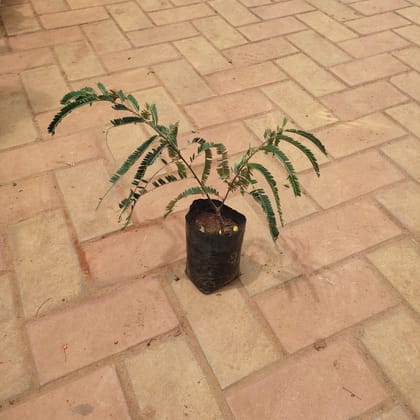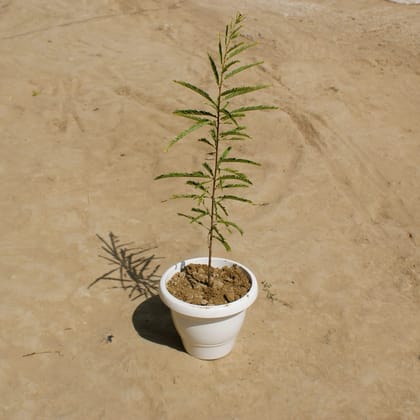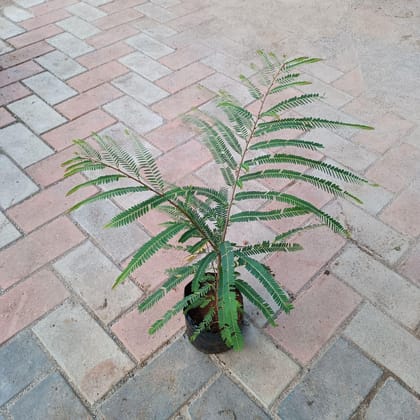- Plants
- Plants
- Home Decor Plants
- Home Decor Plants
- Pots
- Pots
- Soil & Add ons
- Soil & Add ons
- Seeds
- Seeds
- Tools
- Tools
- Decor
- Decor
- Gifting
- Gifting
- Bulk Gifting
- Bulk Gifting
- Gardening Kits
- Gardening Kits
- Outdoor Garden
- Outdoor Garden
- Others
- Others
- Sale
- Sale
- Best Sellers
- Best Sellers
Urvann is your one-stop online nursery for plants, planters, gardening accessories, and tools. Order fresh plants and get free home delivery on the next day!
EN- Home
- Amla Gooseberry Plant
Amla Gooseberry Plant
Buy Amla Plants Online at Urvann
The Amla tree, also known as the Indian Gooseberry, is a native tree of India that grows freely in our country's subtropical climate.
The plant's fruit is considered a Superfruit, loaded with Ascorbic Acid or Vitamin C, which helps build immunity and benefits many other aspects of good health. The gooseberry plant is cultivated throughout the country and is also a part of traditional medicine such as Ayurveda. The amla fruit is round, yellow-green with a sour, bitter taste. Incorporating this wonderful fruiting tree into your home garden will improve overall health.
Why Should I Grow Amla Plants
The antioxidants and other essential vitamins found In the Amla plant offer several health benefits for you and your family. Here are a few of the most popular ones:
IMMUNITY BOOSTERThe amla plant is one of the richest sources of Vitamin C, which helps produce white blood cells (WBCs). WBCs help fight infection in the body, creating a strong immune system. Consumption of a 100-gram serving of fresh amla berries contains as much Vitamin C as is contained in around 20 oranges. Isn’t that wonderful?
PROMOTES HAIR GROWTHDid you know that the amla plant is bursting with Vitamin C? This vitamin is super important for making collagen, which promotes healthy hair growth. It helps create strong hair follicles and keeps your scalp in great shape. How cool is that?
GOOD FOR THE EYESAmla is rich in Carotene, a compound known for its remarkable effects on improving eyesight. A concoction made of amla, honey, and warm water can significantly reduce the number of your eyes. It is also rich in Vitamin A, which is excellent for eyesight.
Care Tips for Amla Plants
The amla ka plant is planted in July and August, and the berries are harvested in late November and December. Here is how you can take care of your plants:
How much water makes my Amla Plants happy?
Provide water to your plant when the surface layer of the soil feels dry and crumbly. Use your finger to check for soil moisture, or even a stick will do the trick. If you feel that the soil is dry, it is time to give the plant a drink.
How much sunshine makes my Amla Plant plants cheerful?
Amla is a happy plant that loves the winter season. Place it in a location where it receives at least 6-7 hours of sunlight so the plant can flower and eventually produce the amla berries.
Which type of soil is best for growing the Amla Plant?
If you want your Amla plants to flourish and stay happy, it’s super important to use a soil mix that drains well and is rich in nutrients. Here’s a simple and friendly recipe you can try: mix together 30% Garden Soil, 30% cocopeat, 35% Vermicompost, and just a little sprinkle of 5% Neem Khali. Your plants will thank you!
When is the best time to fertilise my Amla Plant?
Adding vermicompost or homemade compost every month can do the trick. You can also add liquid fertilisers such as NPK for better growth. Check the instructions on your fertiliser packaging since different brands may have different guidelines.
Why Choose Urvann to Buy Amla Plants Online?
Urvann is excited to offer an exceptional variety of plants, gardening tools, and accessories. If you're looking to purchase Amla plants online for your home garden, you've come to the perfect place. Our collections include some of the healthiest and happiest plants at cost-effective prices, along with free next-day delivery for your convenience. Our dedicated customer support team is always available to help with any plant-related questions or issues. We are committed to making sure you are fully satisfied with your plant selections!
FAQ About Amla Plants
1. How is Amla consumed?
The Amla fruit can be consumed in many forms. It can be had as candies or slices consumed with warm water. Amla supplements such as those in liquid or powdered form can be made at home to support overall health.
2. How can Amla powder be used in cooking?
Amla powder can be used in atta dough, or added to chutneys. As drinks, it can be consumed as amla juice, teas or honey-amla drink.
3. How long does amla plant take to grow?
The Amla plant usually takes 6-7 years to grow from seed. So, it is better to get a healthy sapling to get fruiting faster.
4. In which month does Amla plant give fruit?
Amla berries can be harvested from the plant in the month of December when the weather is perfect.
5. What is the lifespan of Amla Plant?
The Amla plant grows up to become a big tree providing food, shade and shelter. It can last for many decades if cared for properly.
6. Can Amla reverse grey hair?
Regular consumption of Amla in any form has been known to work wonders on hair health, even reversing grey hair or delaying them.
7. What happens if I eat 2 Amlas daily?
Daily consumption of Amla berries helps to strengthen the immune system, building defences against infection.
Buy Amla Plants Online at Urvann
The Amla tree, also known as the Indian Gooseberry, is a native tree of India that grows freely in our country's subtropical climate.
The plant's fruit is considered a Superfruit, loaded with Ascorbic Acid or Vitamin C, which helps build immunity and benefits many other aspects of good health. The gooseberry plant is cultivated throughout the country and is also a part of traditional medicine such as Ayurveda. The amla fruit is round, yellow-green with a sour, bitter taste. Incorporating this wonderful fruiting tree into your home garden will improve overall health.
Why Should I Grow Amla Plants
The antioxidants and other essential vitamins found In the Amla plant offer several health benefits for you and your family. Here are a few of the most popular ones:
IMMUNITY BOOSTERThe amla plant is one of the richest sources of Vitamin C, which helps produce white blood cells (WBCs). WBCs help fight infection in the body, creating a strong immune system. Consumption of a 100-gram serving of fresh amla berries contains as much Vitamin C as is contained in around 20 oranges. Isn’t that wonderful?
PROMOTES HAIR GROWTHDid you know that the amla plant is bursting with Vitamin C? This vitamin is super important for making collagen, which promotes healthy hair growth. It helps create strong hair follicles and keeps your scalp in great shape. How cool is that?
GOOD FOR THE EYESAmla is rich in Carotene, a compound known for its remarkable effects on improving eyesight. A concoction made of amla, honey, and warm water can significantly reduce the number of your eyes. It is also rich in Vitamin A, which is excellent for eyesight.
Care Tips for Amla Plants
The amla ka plant is planted in July and August, and the berries are harvested in late November and December. Here is how you can take care of your plants:
How much water makes my Amla Plants happy?
Provide water to your plant when the surface layer of the soil feels dry and crumbly. Use your finger to check for soil moisture, or even a stick will do the trick. If you feel that the soil is dry, it is time to give the plant a drink.
How much sunshine makes my Amla Plant plants cheerful?
Amla is a happy plant that loves the winter season. Place it in a location where it receives at least 6-7 hours of sunlight so the plant can flower and eventually produce the amla berries.
Which type of soil is best for growing the Amla Plant?
If you want your Amla plants to flourish and stay happy, it’s super important to use a soil mix that drains well and is rich in nutrients. Here’s a simple and friendly recipe you can try: mix together 30% Garden Soil, 30% cocopeat, 35% Vermicompost, and just a little sprinkle of 5% Neem Khali. Your plants will thank you!
When is the best time to fertilise my Amla Plant?
Adding vermicompost or homemade compost every month can do the trick. You can also add liquid fertilisers such as NPK for better growth. Check the instructions on your fertiliser packaging since different brands may have different guidelines.
Why Choose Urvann to Buy Amla Plants Online?
Urvann is excited to offer an exceptional variety of plants, gardening tools, and accessories. If you're looking to purchase Amla plants online for your home garden, you've come to the perfect place. Our collections include some of the healthiest and happiest plants at cost-effective prices, along with free next-day delivery for your convenience. Our dedicated customer support team is always available to help with any plant-related questions or issues. We are committed to making sure you are fully satisfied with your plant selections!
FAQ About Amla Plants
1. How is Amla consumed?
The Amla fruit can be consumed in many forms. It can be had as candies or slices consumed with warm water. Amla supplements such as those in liquid or powdered form can be made at home to support overall health.
2. How can Amla powder be used in cooking?
Amla powder can be used in atta dough, or added to chutneys. As drinks, it can be consumed as amla juice, teas or honey-amla drink.
3. How long does amla plant take to grow?
The Amla plant usually takes 6-7 years to grow from seed. So, it is better to get a healthy sapling to get fruiting faster.
4. In which month does Amla plant give fruit?
Amla berries can be harvested from the plant in the month of December when the weather is perfect.
5. What is the lifespan of Amla Plant?
The Amla plant grows up to become a big tree providing food, shade and shelter. It can last for many decades if cared for properly.
6. Can Amla reverse grey hair?
Regular consumption of Amla in any form has been known to work wonders on hair health, even reversing grey hair or delaying them.
7. What happens if I eat 2 Amlas daily?
Daily consumption of Amla berries helps to strengthen the immune system, building defences against infection.
Filter
- Sort ×
End of product listing
Urvann is your one-stop online nursery for plants, planters, gardening accessories, and tools. Order fresh plants and get free home delivery on the next day!
- Indoor Plants
- Low Maintenance Plants
- Flowering Plants
- Outdoor Foliage Plants
- Religious & Sacred Plants
- Air Purifying Plants
- Cactus & Succulents
- Good Luck Plants
- Plants by Location
- Plants of the Month
- Herbs-Medicinal & Vegetable Plants
- Fruit Plants
- Monsoon Plants
- Hanging Plants
- Potted Plants
- Bonsai Plants
- Special Plant Combos
- Bamboo Plant
- Pet Friendly Plants
- Plants to grow in Water
- Mosquito Repellent Plants
- Climbers & Creepers
Urvann India Private Limited
E-176
Delhi
Delhi 110060
IN
NEWSLETTER
Subscribe to get Email Updates!
Thanks for subscribe.
Your response has been recorded.




